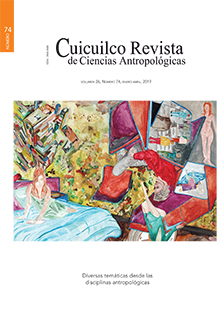Published 2019-07-15
Keywords
- Craft workers, hammered copper, independent artisans, mass production, copper workshops.
How to Cite
Abstract
This article refers to the results obtained through the observation that was carried out –in the year 2017– concerning the changes that the artisanal work in Santa Clara del Cobre, Michoacan., underwent throughout the previous twenty years. Throughout this period, in which the craft workshops and the families that operated them initially occupied part of the courtyards of houses, was transformed to the present reality whereby these same people have become part of large
companies. Currently, these workshops manufacture copper pieces on a large scale in order to serve the international market, above all, that of the usa. The said transformation has thus transcended the actual definition of the worker himself, who was previously a copper craftsman, but who is now given the status of a skilled worker within a workforce renumerated through the salaried factory system. Through the use of a variety of machinery, including cutters, lathes, planing machines and cutting torches, they manufacture hundreds of pieces per month; as a result, the said products have also been transformed from what were once traditional handcrafts, which —through their manual production— possessed the characteristic of being unique and unrepeatable. Nowadays, some of these workshops employ over 50 workers, including supervisors, turners and welders, and have actually increased copper production throughout the region, though this has meant the gradual disappearance of independent craftsmen, individual creativity and the disappearance of the ‘unique’ piece.
Downloads
References
2016 Cobreros, arte a golpe de fuego y martillo, en El Universal, 24 de diciembre de 2016. <http://www.eluniversal.com.mx/articulo/estados/2016/12/24/cobreros-arte-golpe-de-fuego-y-martillo#imagen-1>. Consultado el 14 de
octubre de 2017.
Castro Gutiérrez, Felipe
2017 La extinción de la artesanía gremial. <http://www.historicas.unam.mx/publicaciones/publicadigital/libros/extincion/artesania.htm>. Consultado el 20 de abril de 2018.
Censo de Población y Vivienda INEGI
2010 Cuéntame. Censo de Población y Vivienda, 2010. <https://www.mexico.pueblosamerica.com/i/cuanajo/inegi 2010>. Consultado el 2 de marzo de 2016.
De la Peña, Guillermo
1987 Antropología Social en la Región Purépecha. Colegio de Michoacán. México
Dietz, Gunther
1999 La Comunidad P’urhépecha es nuestra fuerza. Abya – Yala. México.
Franco, Moisés
1998 Manos que producen, en Manufacturas Michoacanas, Verónica Oikión Solano (coord.). El Colegio de Michoacán. Zamora.
Mapa satelital de Santa Clara del Cobre
2018 <https://www.google.com.mx/maps/place/Santa+Clara+del+Cobre,+Mich./@19.3904078,101.8141836,44581m/data=!3m2!1e3!4b1!4m5!3m4!1s
Ox842d8c6081cba8d7:Ox,_>.Consultado el 2 de marzo de 2018.
Miranda, Francisco
1980 La Relación de Michoacán, por Jerónimo de Alcalá. El Colegio de Michoacán. Morelia.
2001 Las Láminas de la Relación de Michoacán. Una descripción. Morelia. Testimonio Compañía Editorial
Novelo, Victoria
2004 La fuerza de trabajo artesanal en la industria mexicana. CIESAS. México.
Oikión, Verónica
1997 Manos michoacanas. El Colegio de Michoacán/Gobierno del Estado. Zamora, Michoacán.
Romero, Carlos
1996 Metales. Abdón Punzo, en Manos mexicanas. Maestros del arte popular, (Primera edición). Empresas La Moderna. México.
Roskamp, Hans
2013 El Lienzo de Jucutacato. La historia sagrada de los nahuas de Jicalán, Michoacán. Arqueología Mexicana 123: 47-54.
Williams, Eduard
2014 La gente del Agua. Etnoarqueología del modo de vida lacustre en Michoacán. El Colegio de Michoacán. Zamora, Michoacán.

